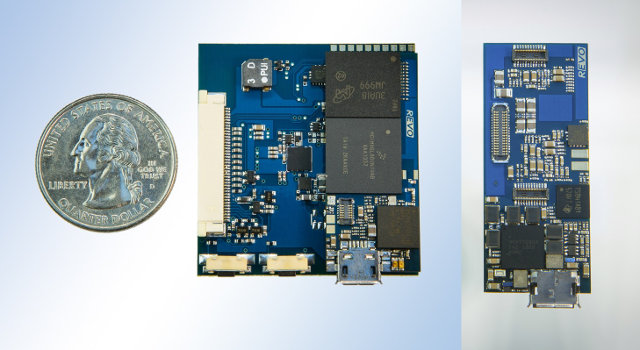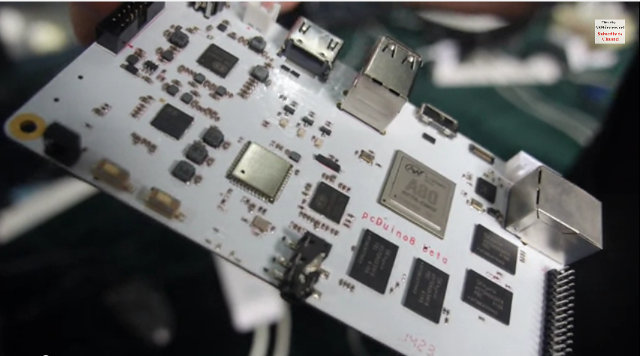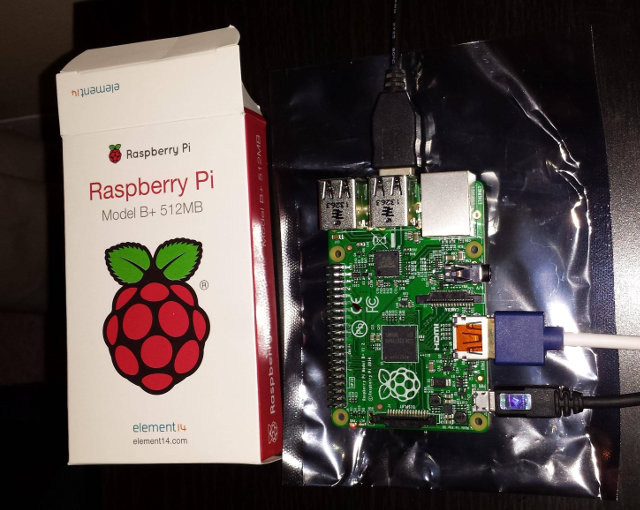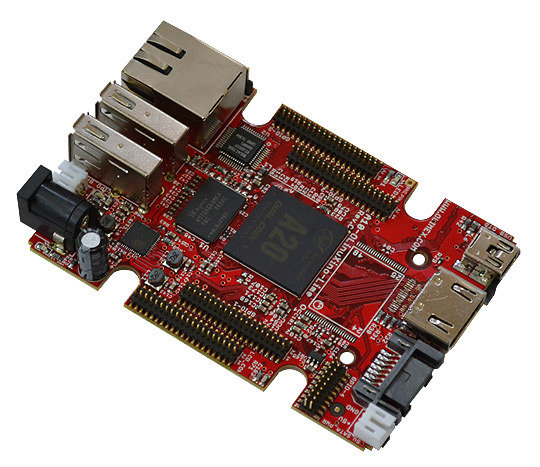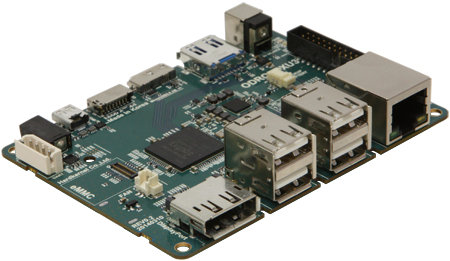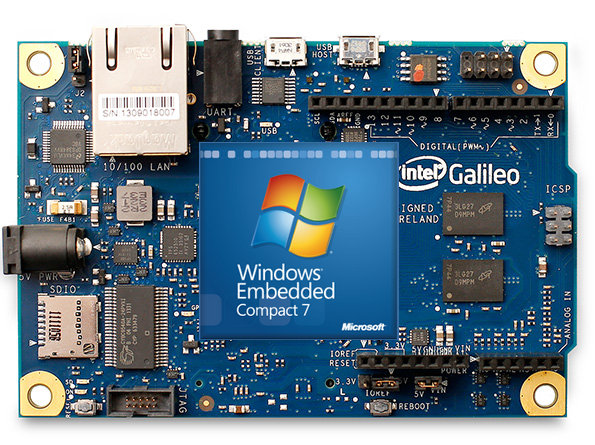We’ve already got a long list of upcoming Rockchip RK3288 based Android media players, but no low cost development boards have been announced to date. We can certainly expect a Radxa Rock 2 board with the Cortex A17 processor, but it might not be the only one, as Firefly-RK3288 development board powered by Rockchip RK3288 is currently being developed by another Chinese team. Current specifications for Firefly-RK3288 board: SoC – Rockchip 3288 quad core ARM Cortex A17 up to 1.8 GHz with Mali-T764 GPU supporting OpenGL ES 1.1/2.0 /3.0, and OpenCL 1.1 System Memory – 2G DDR3 Storage – 8GB eMMC flash + micro SD slot Video I/O HDMI 2.0 up to 3840×2160@60p VGA out (D-SUB connector) VGA in is available via the expansion headers. LCD, MIPI and LVDS Audio Output / Input – HDMI, optical S/PDIF, microphone header, and built-in MIC Connectivity – Gigabit Ethernet, dual band 802.11 b/g/n Wi-Fi with external antenna, and Bluetooth […]
Freescale WaRPBoard Reference Platform for Wearables is Now Available for Pre-order
Back in January, Freescale announced WaRP (Wearable Reference Platform) comprised of the WaRPboard, a tiny board based on Freescale i.MX 6SoloLite running Android, and a daughter board with KL16 Cortex M0+ MCU and several sensors. The company collaborated with Revolution Robotics for the hardware design, and Kynetics for the software, and the platform is now available for pre-order for $149, and a few more details have surfaced since my first article. The hardware specifications of WaRP are as follows: WaRPboard: SoC – Freescale i.MX 6SoloLite Cortex A9 processor @ 1GHz with 2D graphics Vivante GC355 and GC320 GPUs. System Memory – LPDDR2 (Micron Multi-Chip Package) Storage – 4Gbit eMMC (Same Micron MCP chip as for RAM) Connectivity – WLAN and Bluetooth 4.0 LE via Murata LBEH17YSHC Display I/F: MIPI DSI for LCD display + touchscreen EPCD for E-Ink Display Sensors – Xtrinsic FXOS8700CQ, 6-Axis Sensor with Integrated Linear Accelerometer and Magnetometer. Daughtercard: […]
PcDuino8 Octa-core Development Board Revealed (Video)
Two AllWinner A80 powered development boards are currently expected. We’ve already seen some pictures of the Cubieboard8, and today we can gt more details about PcDuino8 development board thanks to Charbax who visited Linksprite, and interviewed the company. Here are PcDuino8 (Beta) specifications based on the interview and pictures: SoC – AllWinner A80 octa core big.LITTLE processor with 4 ARM Cortex A15 cores, 4 Cortex A7 cores, and Imagination PowerVR G6200 GPU System Memory – 1GB Storage – 4GB flash + micro SD Card slot Video Output – HDMI Audio Output – HDMI, stereo audio jack Connectivity – Gigabit Ethernet, Wi-Fi 802.11 b/g/n + Bluetooth 4.0 (AP6330 module) USB – 2x USB 2.0 host ports, 1x Micro-B USB 3.0 port Debugging – 14-pin header for JTAG Expansion Header – 32-pin header Misc – IR receiver Power – Round DC power jack (5V?) The hardware specs are a bit lower compared […]
Intel Announces Galileo Gen 2 Development Board Based on Quark SoC
As many of us are waiting for our Intel Galileo board promised by Microsoft, and right after the Raspberry Pi foundation announced the Raspberry Pi Model B+, Intel has introduced a new version of the Galileo board which they simply call Galileo Gen 2. The development board is still powered by Intel Quark single core SoC (Pentium class) and with the same key features as the original Galileo Board, but with some tweaks based on the feedback from the community. Intel Galileo Gen 2 specifications (Changes in Bold): SoC- Intel Quark SoC X1000 single core, single-thread application processor @ 400 MHz, with 12KB embedded SRAM System Memory – 256MB DDR3, 5 Storage – 8MB NOR fklash, 8KB EEPROM, and micro SD card slot (up to 32GB) Connectivity – 10/100M Ethernet USB – 1x USB 2.0 host port, 1x micro USB 2.0 device port used for programming Debugging / Programming 10-pin […]
Raspberry Pi Model B+ with 4 USB Ports, a micro SD Slot, and More GPIOs Coming Soon
With over 3 million boards sold, the Raspberry Pi is by far the most popular ARM Linux board on the market, but people are often asking for hardware upgrades with a faster processor, more RAM and so on. The good news is that a new Raspberry Pi board seems on the way, but since the real competitive of the Raspberry Pi is not the cheap hardware only, but software support and the community around the little ARM board. So instead of designing of completely new board, they’ve kept Broadcom BCM2835 and 512MB RAM, and mostly made some changes to the ports, and form factor. Since the board has not been officially announced just yet, the full details are available, but according to various reports, the specs should be as follows: SoC – Broadcom BCM2835 ARM11 processor @ 700MHz with VideoCore IV GPU System Memory – 512 MB SDRAM (PoP) Storage […]
33 Euros Olimex A20-OLinuXino-LIME Open Source Hardware Board Supports Linux and Android
Last year, Olimex launched A10-OLinuxXino-LIME powered by AllWinner A10, and it became quite popular due to its Linux and Android support, its open source hardware, and a price tag of just 30 Euros that made it cost competitive with BeagleBone Black and Raspberry Pi boards. The company has now designed an upgrade with A20-OLinuXino-LIME powered by AllWinner A20 dual core Cortex A7 processor, that sells for just 3 Euros more. A20-OLinuXino-LIME specifications: SoC – AllWinner A20 dual core ARM Cortex-A7 @ 1GHz with Mali-400MP2 GPU System Memory – 512MB DDR3 Storage – microSD card slot, SATA, and optional 4GB NAND Flash Video Output – HDMI 1080p USB – USB-OTG + 2x USB Hosts Connectivity – 10/100Mbit Ethernet Expansions – 200 GPIOs on 0.05″ connectors Misc – Lipo battery management and connector, buttons Power – 5V Dimensions – 84 x 60 mm The specifications are exactly the same expect for the […]
Hardkernel Unveils $179 ODROID-XU3 Development Board Powered by Samsung Exynos 5422 SoC
Remember ODROID-XU2 development board based on Exynos 5420? The bad news is that it apparently got scrapped, but the good news is that it gave birth to ODROID-XU3 development board powered by the latest Samsung Exynos 5422 octa core big.LITTLE SoC with support for Ubuntu 14.04 and Android 4.4, including GPU 3D acceleration with the company promising a full desktop experience in Ubuntu. ODROID-XU3 specifications: SoC – Samsung Exynos 5422 quad core ARM Cortex-A15 @ 2.0GHz+ quad core ARM Cortex-A7 @ 1.4GHz with Mali-T628 MP6 GPU supporting OpenGL ES 3.0 / 2.0 / 1.1 and OpenCL 1.1 Full profile System Memory – 2GB LPDDR3 RAM PoP (933Mhz, 14.9GB/s memory bandwidth, 2x32bit bus) Storage – Micro SD slot (up to 64GB) + eMMC 5.0 module socket (16, 32, or 64GB module available) Video Output – micro HDMI (Up to 1080p) and DisplayPort (up to 2160p) Audio Output – micro HDMI and […]
Microsoft is Giving Away Intel Galileo Arduino Compatible Boards to Developers
Microsoft has already launched several initiatives to reach the maker movement and app developers with .NET Gadgeteer supported by platform like Bambino 200, as well as Intel Shark Cove development board for Windows development. The company has now launched a website called windowsondevices.com where they currently have a signup page for developers to send a kit based on Intel Galileo, an Arduino compatible board powered by Intel Quark processor. There’s currently very little information on the software and documentation part of the development kit, but there are links to Visual Studio Express, Windows Embedded’s Internet of Things page, and a link to Maker Faire, so it gives what the kit will be for. Apparently they’ll send the kit to selected candidate whether “you are an experienced Windows developer looking to jump into the Internet of Things or you are new to Windows development and want to build the next big […]



